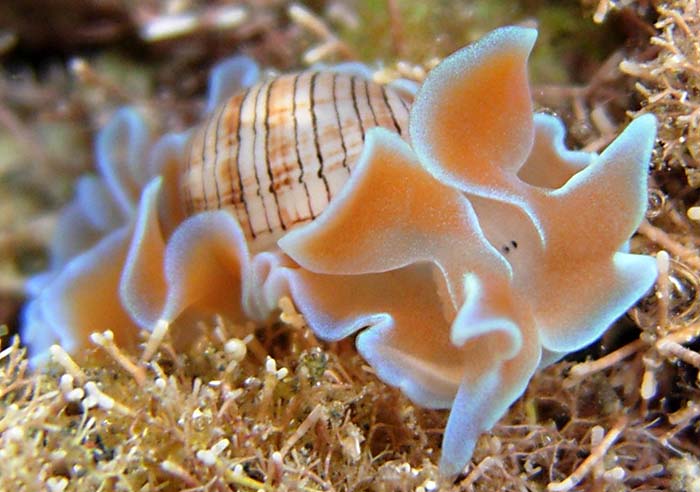This species has been observed on Reunion, Mauritius, Mayotte and Seychelles Islands
The shell has numerous and unequal spiral brown or black lines The animal is quite variable in its colour shading. It can range from this very dark (pink or red) form to a pale pinkish with an opaque white or blue marginal line around the foot. The front of the head shield is developed into a pair of large and lobe-like tentacles on each side. |

|
|
| Showing species characteristics... | Photo Philibert Bidgrain |
|
Remarks :
Identification confirmed by Nathalie Yonow
Synonymous : (according Worms)
- Aplustrum virgatum Mörch, 1852 - Bulla quoyana d'orbigny, 1845
- Bulla atrolineata Schröter, 1804 - Bulla staminea Menke, 1853
- Bulla physis Linnaeus, 1758 - Hydatina filosa Schumacher, 1817
Bibliographic data :
The Hydatinidae are the most modified of a group of cephalaspids which show the gradual diminution in the importance of the shell as a protective organ .In Hydatina and Micromelo the shell has become thin and the animal large and brightly coloured.
The animal, can retract back into their shell but they seldom do. Most other mollusks have a solid shell and a central heavily calcified columella around which the shell, and animal, spirals. There is a huge columella muscle which attaches the animal to the shell and can quickly pull the animal back inside when necessary. In Hydatina, in which the shell is becoming reduced in importance, the columella has become very reduced, as has the associated columellar muscle, so their poor ability to retract back into their shell
They rely on distasteful acid glands in their skin and burrowing in the sand to protect them.
The protective operculum has disappeared.
It feeds on Cirratulinae, a subfamily of the Cirratulinidae polychaete worms..
The cirratulids have no head appendages but have long thread-like tentacles along most of the body but especially around the head. They live in crevices, empty burrows or under rocks partially embedded in the sand or mud. They live surrounded by a "coccoon'" of debris, and they extend their tentacles out like the head tentacles of terebellid worms, to collect food particles.
The egg ribbon of Hydatina is highly convoluted and is attached to the sand by a mucus thread.
It seems that anchoring the ribbon is the last stage in the process and only occurs after all the ribbon is completely exuded from the genital opening. A quite different process than that of nudibranchs and other opisthobranchs which gradually attach the ribbon as it is being exuded.
Often found in shallow waters, usually not deeper than 5 m, crawling over or through sandy substrate. It inhabits sands flats and rock pools
Material examined by Nathalie Yonow ( see reference/publications).
Two specimens collected from Flic en Flac, 15 October 1985, shell size : 23x18 and 22x17 mm. And one from Grand Baie, 2 November 1985, shell size : 33x23 mm
References :
Bill Rudman Seaslug site : Sea Slug Forum : Hydatina physis
Nudipixel Hydatina physis
Publications :
Rudman, W.B., 1972. The anatomy of the opisthobranch genus Hydatina and the functioning of the mantle cavity and alimentary canal. Zoological Journal of the Linnean Society, 51: 121-139.
Yonow, N. and Hayward , P. J. (1991). Opistobranches de l'île Maurice, avec la description de deux espèces nouvelles (Mollusca : Opistobranchia) Revue française d'aquariologie herpétologie, 18 (1), 1-30
Other photos of Hydatina physis :
 |
Christophe Cadet Reunion, Etang salé les bains on the rocky coast, less 1 m,18 December 2015, size : 25 mm The mantle cavity with the gills (a) faces the right side of the animal
|
 |
Christophe Cadet Reunion, Etang salé les bains on the rocky coast, less 1 m, 26 January 2016, size : 25 mm During the night.
With its spawn... The egg ribbon of Hydatina is highly convoluted and is attached to the sand by a mucus thread. A quite different process than that of nudibranchs and other opisthobranchs which gradually attach the ribbon as it is being exuded. |
Christophe Cadet Reunion, Etang salé les bains on the rocky coast, less 1 m, 28 October 2008, during the night. A mating behavior...
|
 |
 |
Christophe Cadet Reunion, Etang salé les bains on the rocky coast, less 1 m, 12 December 2009, size : 20 mm. 4 specimens observed on this day... |
Maurice Jay
Reunion, In this specimen, you can observe filamentous green algae on the shell. We have found specimens with a similar crop on its shell in two other species in Reunion Island. In Haminoea cymbalum and in Micromelo undata |
 |
 |
Hugues Flodrops Reunion, Etang salé les bains on the rocky coast, less 1 m, 9 December 2007, size : 15 mm.
|
Hugues Flodrops Reunion, "Grande Anse pool", less 1m, 11 January 2008, during the night, shell size : 15 mm |
 |
In Nudibranches of Seychelles by Christophe Mason-Parker Observed at Baie Ternay, Mahé, size : 30 mm
|
Available online on Archipelago Island
|
More photos from Indian Ocean
Mauritius, drawing of a specimen of Hydatina physis, from Grand Baie, by Nathalie Yonow
Mayotte, Hydatina physis, at Petite Terre, by Norbert Verneau
